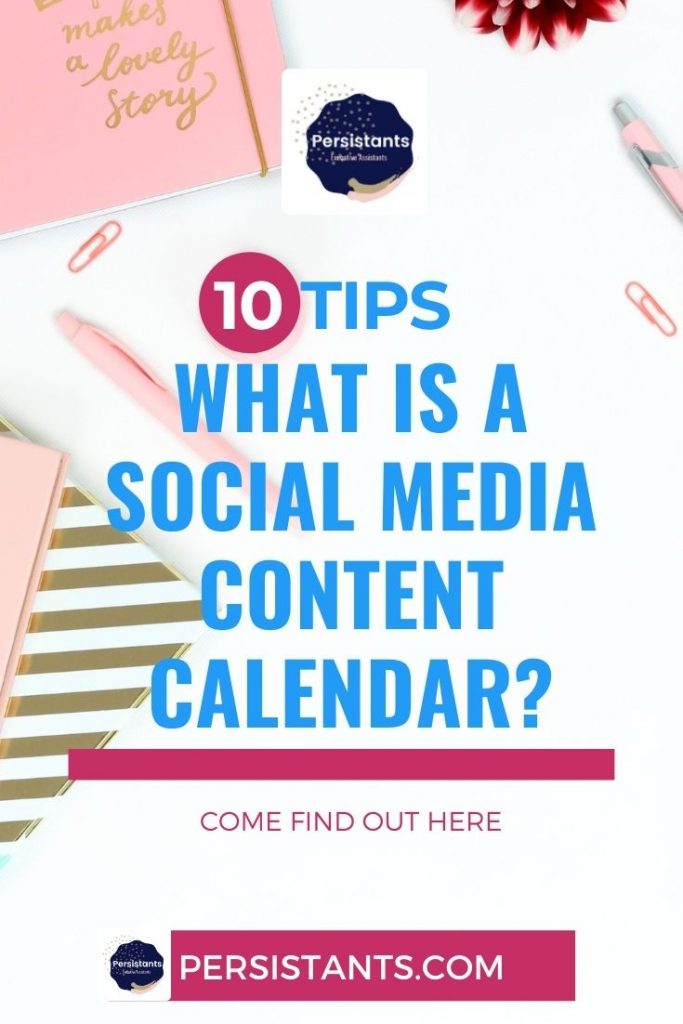What is a Social Media Content calendar?
Social media content calendars help keep your publishing schedule organized. I know, I know. Obvious, right? But you’d be surprised—despite this very clear benefit—how many brands fail to use a Social Media content calendar.
The Benefits of Using a Social Media Content Calendar ( and no it’s not the same thing as your Marketing Calendar) are as follows:
1 ) Keeps You Organized
Staying organized not only means you remember important dates, and to do’s as you plan your day it also means that you know what you’re publishing, where, and when. Don’t underestimate the impact this kind of planning can have on the efficiency of your social media marketing plan.
Additionally, a content calendar helps you establish a regular cadence for each of your social channels and stick to it.
And, of course, any social media manager knows that consistency is key. A Social Media content calendar can help ensure that you don’t run the risk of spamming one social media platform or tribe, while neglecting another.
With today’s Social Media Market’s expected increase of Engagement, it’s more important now than ever to have a social media content calendar to support your greater social media marketing plan. ( and Like I said earlier they are not the same thing.)
Do you have your Social Media Content Calendar?
Here is my FREE Gift to you. I created the Persistants Social Media Editorial Content Calendar/ planner for you.
Why? Because I know how busy you are.

Just sign up below and it will be sent directly to your Inbox, faster than you can say Persistants Executive Assistant is Awesome, and I love their Social Media Content & Editorial Calendar! Now tweet that!
[BTEN id=”15161″]
Why Do You need a Social Media Calendar?
1. Never miss important dates
One of the key things a content calendar must contain is key dates that matter to your business—holidays, events, product launches, campaigns, and more.
This allows you to plan content for those dates and ensure that you don’t end up scrambling.
Additionally, a content calendar is a good place to document performance. For example, if your brand operates in the B2B space, you may find that the winter holidays result in click-throughs as your target audience isn’t at work.
Include this information in your content calendar so you can plan accordingly. For example, you might switch to a lower publishing volume or rely on reposting content rather than pushing new content.
2. Organize and Plan out your content
Social media content calendars help keep your publishing schedule organized. I know, I know. Obvious, right? But you’d be surprised—despite this very clear benefit—how many brands fail to use a content calendar.
Staying organized not only means you remember important dates, it also means that you know what you’re publishing, where, and when. Don’t underestimate the impact this kind of planning can have on the efficiency of your social media marketing plan.
Additionally, a content calendar helps you establish a regular cadence for each of your social channels and stick to it.
And, of course, any social media manager worth their salt knows that consistency is key. A content calendar can help ensure that you don’t run the risk of spamming one network while neglecting another.
3. Collaborate easily
Another great thing about social media content calendars? They make it easier to work with a team.
Whether you’re sharing information with stakeholders or updating your team, this calendar serves as the single source of truth for what’s being published and when.
This is made especially easy if you host your calendar on a cloud platform designed to promote collaboration, such as Google Sheets or an Excel spreadsheet in Dropbox.
4. Save You time
The inherent organization of content calendars fosters efficiency. Planning content ahead, knowing when you’re sharing evergreen assets when you’re pushing new content, and when you’re curating items from other creators will save you time in the long run.
5. Effectively allocate resources
Rather than making last-minute asks of your long-suffering copywriters and very patient video team, you can instead assign things well in advance, providing ample time for research and creation, thus ensuring you rarely miss a deadline.
Having a content calendar means you’re more likely to publish your content precisely when you intend to and at the quality level you expect.
6. Gain a deeper understanding of successful content
Careful planning of your social media content will also help you gain a better understanding of what makes a good piece of content, enabling you to increase your success rate and create more of what your audience wants to see.
How?
First, it frees up time for you to devote to measurement instead of last-minute publishing.
Secondly, it provides a clear framework and structure for your content activities, meaning you’re more likely to notice patterns. Perhaps content that goes out on Thursday does better, or your daily how-to post beats out all your other content.
This deeper understanding can help you determine optimal post times, who your audience is, and what they want to see. This will ultimately make it easier to duplicate what’s working.
How to create a social media content calendar
1. Think about your audience
Good content should always start in the same place: your audience. That means knowing your audience inside and out.

Here are the three key benefits of creating a distinctive personal brand:
1. Have your social media content stand out in crowded social streams by
having a consistent visual identity that is easily recognizable.
2. Travel the world and work from anywhere on your laptop and still be able
to land remote jobs, attract new clients and sell your products or services online.
3. Build your social influence and your professional network faster with a
clear and concise story of the problems you solve for your audience and what makes you different.
[BTEN id=”15161″]
The best way to understand your audience—and easily evaluate whether they’d be interested in a particular type of content—is to create audience personas. These archetypes provide a window into what your typical audience members look like, including demographic details about them as well as their wants, needs, goals, and pain points.
While it’s important to map out your existing audience members and think about what content they want to see, you can also explore who you want to have viewing your content. This information can be captured in aspirational personas that reflect your target audience.
Whether you’re looking at your existing audience or your target audience, your personas should inform the content you create. Not sure if you should create a certain piece of content?
Ask yourself if it aligns to one of your personas. If it doesn’t, then you probably shouldn’t be investing resources into it.
2. Research what content resonates
In order to plan and create successful content, you need to know what success looks like. Start by looking at the content you’ve produced in the past and examine what worked.
Ask yourself:
- What content got the most likes?
- What content got the most comments?
- What content got the most shares?
- What content got the most views?
What content got the highest engagement rate?
For a better understanding of what to measure and why, check out our posts about social media metrics that matter and video metrics that matter.
3. Audit existing content
Now that you know what works, look at what content you actually have.
Go through your existing library and identify types and categories. For example, in terms of content types, your business might create blog posts, videos, and webinars. In terms of content categories, you might have Q&As, how-tos, and listicles.
Ask yourself the following questions:
- What’s still useable?
- What can be updated?
- What can be repurposed?
- What can’t be reused?
All items that fall into the first three categories have the potential to become evergreen content that will form the basis of your content calendar.
4. Create an overview of major events
Once you’ve taken stock of your content assets, set them aside (for now).
Create a calendar—this can take the form of a doc, spreadsheet, or even an actual calendar
—and map out important events throughout the year, particularly those that you want to create content around.
Be sure to include:
- Holidays (big and small)
- Product launches
- Campaigns
- Annual events or features
Depending on your business, this calendar may also include fun offbeat holidays, such as National Trivia Day and National Donut Day (of which there are two).
If your business is affected by seasonality, be sure to include this in your calendar. For example, if you’re a B2B company and there tends to be a lull at the end of December, mark this on your calendar so that you can plan accordingly by reducing the amount of content published or saving top content for a higher traffic time.
5. Figure out calendar processes
You’ve got your evergreen content and you’ve got your bare-bones calendar—now it’s time to figure out the nitty-gritty of your schedule.
First, decide how often you’re going to publish on each social network.
Next, determine your content mix—that is, how much of each type and category of original content you’ll publish, as well as how much-curated content you plan to share.
This should typically be expressed as a ratio. A good rule of thumb is the 80-20 rule: share 80 percent helpful and interesting content for every 20 percent of content where you’re trying to sell your product.
Additionally, determine how you’ll generate new content ideas and the process by which they’ll be made a reality. For example, here on the Persistants’ Blog, we hold monthly brainstorms, assign ideas to our internal content team, and plug those assignments into our editorial calendar.
From there, figure out a process for identifying and sharing quality curated content. Establish who on your team will be responsible for updating the calendar and who’s in charge of scheduling content to be published on social networks.
7. Plan and schedule content ahead of publication
Now that you’ve marked all the important dates—and I do mean ALL—on your content calendar and set up a process for content planning, it’s time for the fun part: new content.
First off, strategize larger themes that you’d like to tackle. For example, you might have a beverage company and want to run a summer campaign about your newest flavor option.
Choose the themes you want to run with and map them onto your calendar. As you do this, keep in mind that it’s better to do a few things well than to do everything poorly. Narrow possible themes down to key priorities.
Once you have themes to go along with your dates, it’s time to figure out your individual content pieces.
Start with a brainstorm. Pull in creative people from across teams (after all, you don’t have to be a content creator to come up with great ideas). At Persistants we invite members of multiple teams in because we know they have different perspectives on the topics we’d like to cover. After our brainstorm session, we take the raw ideas, choose our favorites, refine them, assign them, and then add them to our content calendar.
If you have big upcoming events in your calendar that you want to plan content around, ensure that that’s reflected in the themes of your brainstorm sessions and, of course, that you leave adequate time for content tasks to be resourced. After all, you could have the best Christmas-themed campaign in mind, but no one will want to see it if you can’t finish it until January.
Plan your content, create your content, then schedule your content. Simple in theory, much harder in practice. But, with a little organization, you can maintain a social media content calendar that will help your team be more efficient and create better quality content—on time, every time.
Editorial and content calendar examples
When it comes to long-term editorial planning, few organizations are more in tune than magazines. Because of their regular cadence, publishing restrictions, and reliance on annual features or seasonal topics, most major magazines plan themes—and even specific content—for an entire year in advance.
While the content you’re planning will likely be a tad different than the average magazine, seeing how this is done can be incredibly helpful.
And you’re in luck:
because of the process, we have created our Editorial Calendar just for you!



